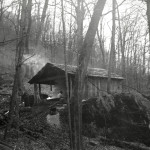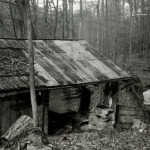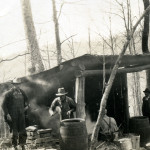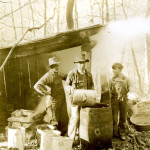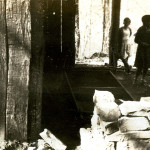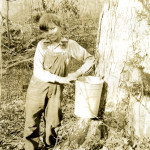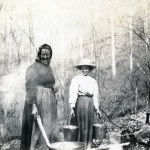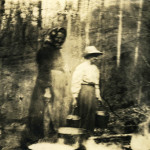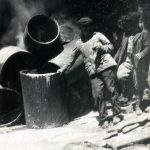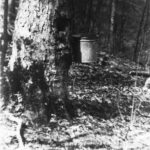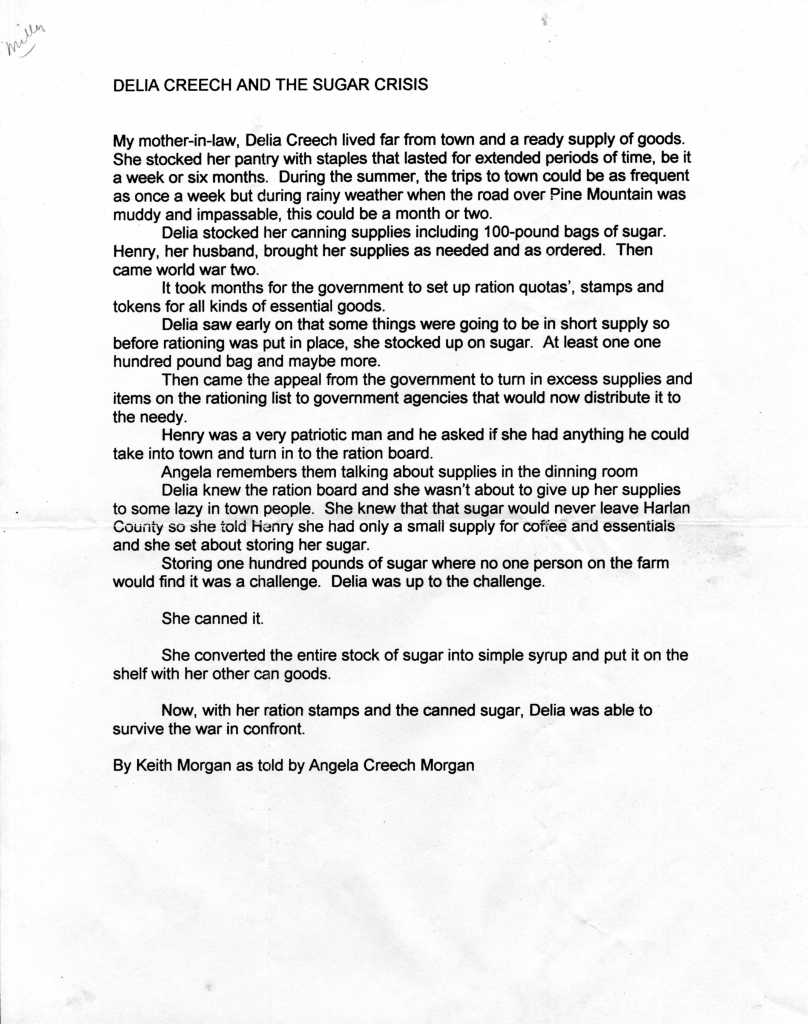Pine Mountain Settlement School
FARM 11: FARM AND FARMING
Series: BY TOPIC – FOODWAYS
Maple Syrup and Sugar
MAPLE SYRUP and SUGAR
Tags: maple syrup and sugar ; maple sugar ; maple syrup ; maple sugar camp ; maple trees ; William Creech ; Henry Creech ; sugar maple trees ;
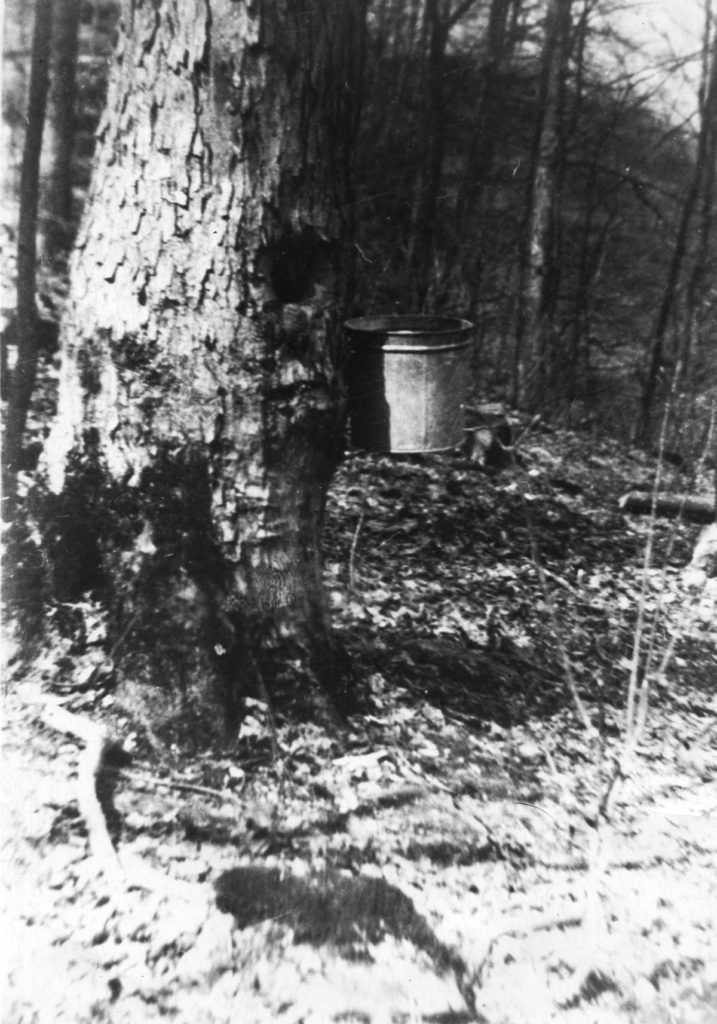
Sugar Maple tree with bucket to catch the sap of tree. Henry Creech’s maple sugar camp. [misc_exhibit_014.jpg]
MAPLE SYRUP and SUGAR: Tapping the Sugar Maple Tree
The tapping of maple sugar trees was common in the first decades of the twentieth century but by the early 1970s only one-quarter of the national production level of the earlier years was realized. The art of harvesting the sweet sap of the sugar maple has given way to artificial syrups and the difficulty and unpredictable nature of tapping sugar maples have given way to a quick trip to the supermarket. But, those who have ever broken a chunk from a cake of maple sugar and have slowly let it dissolve in their mouth can testify to the very special nature of real maple sugar or maple syrup. There is no comparison. The Creech family who lived close by the Settlement School had the skill of harvesting this natural sweetener and passed along their knowledge to Pine Mountain Settlement School staff.
MAPLE SYRUP and SUGAR: Gallery I
- [Maple sugar camp. Henry Creech’s ?] [nace_1_077a.jpg]
- Maple sugar camp. Henry Creech’s ? [nace_1_077d.jpg]
- “Bill Creech, Gib Lewis, Columbus [Creech], Henry [Creech] Stir-off.” Maple sugar stir-off at the maple sugar camp. [kingman_071c.jpg]
- Creech’s maple sugar camp. [kingman_008b.jpg]
- Creech’s maple sugar camp (?). [kingman_008a.jpg]
- “Charles Creech” (son of Delia & Henry Creech) with maple syrup bucket at tree. [kingman_008c.jpg]
- Aunt Sal and Ethel de Long [?] boiling down maple syrup. [Vl_37_1202.jpg]
- Friends & Family: VI 37 Aunt Sal and Ethel de Long processing maple syrup to make sugar. [VI_37_1198.jpg]
- Creech Maple Sugar Camp. [nace_1_046b.jpg]
- Maple sugar vats? 047_IV_FN_07_040
MAPLE SYRUP and SUGAR: History
The following account is given of the history of maple syrup at Pine Mountain Settlement School. The author is unknown. The typewritten original was found in the personal papers of Fern Hayes, a secretary at Pine Mountain from 1938 until 1953.
MAPLE SYRUP AND PINE MOUNTAIN SETTLEMENT SCHOOL
One of the features that William Creech discovered on the north side of Pine Mountain was a grove of mature sugar maple trees. It is not known whether he knew about the trees before he registered his land grant, but the trees that caught his eye were in Tan Troff Hollow, about mid-way of his land along the northern side of Pine Mountain. Tan Troff Hollow is the eastern-most boundary of the present main campus of the Pine Mountain Settlement School.
Uncle William made spouts to insert into maple trees in order to collect sap in the early Spring. The sap was boiled, stirred and skimmed until it thickened and a “sugar camp” shed, boiling pans, and collecting apparatus was the focus of the maple syrup work. Uncle William split and hollowed small trees to form troughs that were arranged so that the sap could be poured to barrels at the camp, instead of being carried down the mountainside. The use of the trough prevented many a spill of sap, as workers slipped on ice and snow, or tripped over rocks.
Workers at the School introduced Uncle William and his sons, Henry and Columbus in particular, to the metal spouts that held collecting buckets next to the tree. The metal products were obtained and used for a number of years and both maple syrup and sugar became a staple in the family diet. It is unclear how much of the syrup found its way onto the campus. Certainly it was a gift to various workers and also graced the table for entertaining guests from the School.
One of the School workers, Marguerite [Butler] Bidstrup worked closely with Uncle William, who, as postmaster, was required to submit periodic accounting of postal materials. Marguerite undertook the task to balance the books and to prepare the report. She also helped with accounts in the general store Uncle William operated in connection with the post office. She spoke of maple syrup and biscuits in the Creech home. She also baked yeast bread for Uncle William late in his life and maple syrup was eaten with the bread.
Many Boarding School students may recall the Dogwood Breakfast tradition. For several years during the Community School era, the tradition was maintained and a Dogwood Breakfast became an integral part of the Spring meeting of the Board of Trustees. For the Board breakfasts, Henry Creech furnished maple syrup, made from the trees at Uncle William’s sugar camp.
When Uncle William divided his land, he asked his two sons, Henry and Columbus, who were to share the grove of sugar maple trees, not to log the site. He liked the idea that part of the mountain would remain untouched. And so it was not logged until after Henry’s and Columbus’ times. However, maple trees in the grove died during the many years of syrup making. The dead trees, along with other trees in and around the maple grove, were felled and sawed and chopped for firewood for boiling sap.
[**Possibly written by Jane Bishop Hobgood. Mailed to Fern Hall Hayes in the 1980s by Jane Bishop Hobgood.]
MAPLE SYRUP and SUGar: Delia Creech and the Sugar Crisis
Obviously, sugar was a major staple of the Creech family, as they had long had access to some of the best. When WWII brought a rationing mandate on sugar consumption, the Creech family were no longer dependent on the maple grove for their supply of sugar. The thought that the store supply would be limited brought about a creative solution to the rationing mandate. The following account was sent to Milly Mahoney, a teacher at the School, from Keith Morgan, a relative of the William Creech family sometime in the 1980s. Keith’s wife, Angela, is the daughter of Delia and Henry Creech. Henry Creech was the son of William Creech. She recounts this story told to her by her mother, Delia.
DELIA CREECH AND THE SUGAR CRISIS
My mother-In-law, Delia Creech, lived far from town and a ready supply of goods. She stocked her pantry with staples that lasted for extended periods of time, be it a week or six months. During the summer, the trips to town could be as frequent as once a week but during rainy weather when the road over Pine Mountain was muddy and Impassable, this could be a month or two.
Delia stocked her canning supplies including 100-pound bags of sugar. Henry, her husband, brought her supplies as needed and as ordered. Then came World War II. It took months for the government to set up ration quotas, stamps and tokens for all kinds of essential goods.
Delia saw early on that some things were going to be in short supply so before rationing was put In place, she stocked up on sugar. At least one one-hundred-pound bag and maybe more. Then came the appeal from the government to turn in excess supplies and items on the rationing list to government agencies that would now distribute it to the needy.
Henry was a very patriotic man and he asked if she had anything he could take into town and turn in to the ration board.
Angela remembers them talking about supplies in the dining room. Delia knew the ration board and she wasn’t about to give up her supplies to some lazy in-town people. She knew that that sugar would never leave Harlan County so she told Henry she had only a small supply for coffee and essentials and she set about storing her sugar.
Storing one hundred pounds of sugar where no one person on the farm would find It was a challenge. Delia was up to the challenge. She canned it. She converted the entire stock of sugar into simple syrup and put it on the shelf with her other can goods. Now, with her ration stamps and the canned sugar, Delia was able to survive the war in comfort.
By Keith Morgan as told by Angela Creech Morgan.
MAPLE SYRUP and SUGAR: Gallery II
Tapping the Maple Sugar Tree
- Sugar Maple tree with bucket to catch the sap of tree. [misc_exhibit_014.jpg]
Delia Creech and the Sugar Crisis
BY TOPIC
MAPLE SUGAR CAMPS
AT HENRY CREECH’S
AT PINE MOUNTAIN

